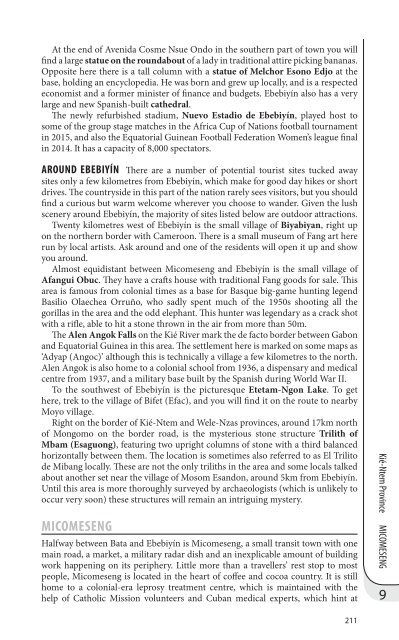Equatorial Guinea
Equatorial%20Guinea%20sample%20chapter_3ZIN
Equatorial%20Guinea%20sample%20chapter_3ZIN
You also want an ePaper? Increase the reach of your titles
YUMPU automatically turns print PDFs into web optimized ePapers that Google loves.
At the end of Avenida Cosme Nsue Ondo in the southern part of town you will<br />
find a large statue on the roundabout of a lady in traditional attire picking bananas.<br />
Opposite here there is a tall column with a statue of Melchor Esono Edjo at the<br />
base, holding an encyclopedia. He was born and grew up locally, and is a respected<br />
economist and a former minister of finance and budgets. Ebebiyín also has a very<br />
large and new Spanish-built cathedral.<br />
The newly refurbished stadium, Nuevo Estadio de Ebebiyín, played host to<br />
some of the group stage matches in the Africa Cup of Nations football tournament<br />
in 2015, and also the <strong>Equatorial</strong> <strong>Guinea</strong>n Football Federation Women’s league final<br />
in 2014. It has a capacity of 8,000 spectators.<br />
AROUND EBEBIYÍN There are a number of potential tourist sites tucked away<br />
sites only a few kilometres from Ebebiyín, which make for good day hikes or short<br />
drives. The countryside in this part of the nation rarely sees visitors, but you should<br />
find a curious but warm welcome wherever you choose to wander. Given the lush<br />
scenery around Ebebiyín, the majority of sites listed below are outdoor attractions.<br />
Twenty kilometres west of Ebebiyín is the small village of Biyabiyan, right up<br />
on the northern border with Cameroon. There is a small museum of Fang art here<br />
run by local artists. Ask around and one of the residents will open it up and show<br />
you around.<br />
Almost equidistant between Micomeseng and Ebebiyín is the small village of<br />
Afangui Obuc. They have a crafts house with traditional Fang goods for sale. This<br />
area is famous from colonial times as a base for Basque big-game hunting legend<br />
Basilio Olaechea Orruño, who sadly spent much of the 1950s shooting all the<br />
gorillas in the area and the odd elephant. This hunter was legendary as a crack shot<br />
with a rifle, able to hit a stone thrown in the air from more than 50m.<br />
The Alen Angok Falls on the Kié River mark the de facto border between Gabon<br />
and <strong>Equatorial</strong> <strong>Guinea</strong> in this area. The settlement here is marked on some maps as<br />
‘Adyap (Angoc)’ although this is technically a village a few kilometres to the north.<br />
Alen Angok is also home to a colonial school from 1936, a dispensary and medical<br />
centre from 1937, and a military base built by the Spanish during World War II.<br />
To the southwest of Ebebiyín is the picturesque Etetam-Ngon Lake. To get<br />
here, trek to the village of Bifet (Efac), and you will find it on the route to nearby<br />
Moyo village.<br />
Right on the border of Kié-Ntem and Wele-Nzas provinces, around 17km north<br />
of Mongomo on the border road, is the mysterious stone structure Trilith of<br />
Mbam (Esaguong), featuring two upright columns of stone with a third balanced<br />
horizontally between them. The location is sometimes also referred to as El Trilito<br />
de Mibang locally. These are not the only triliths in the area and some locals talked<br />
about another set near the village of Mosom Esandon, around 5km from Ebebiyín.<br />
Until this area is more thoroughly surveyed by archaeologists (which is unlikely to<br />
occur very soon) these structures will remain an intriguing mystery.<br />
MICOMESENG<br />
Halfway between Bata and Ebebiyín is Micomeseng, a small transit town with one<br />
main road, a market, a military radar dish and an inexplicable amount of building<br />
work happening on its periphery. Little more than a travellers’ rest stop to most<br />
people, Micomeseng is located in the heart of coffee and cocoa country. It is still<br />
home to a colonial-era leprosy treatment centre, which is maintained with the<br />
help of Catholic Mission volunteers and Cuban medical experts, which hint at<br />
Kié-Ntem Province MICOMESENG<br />
9<br />
211


